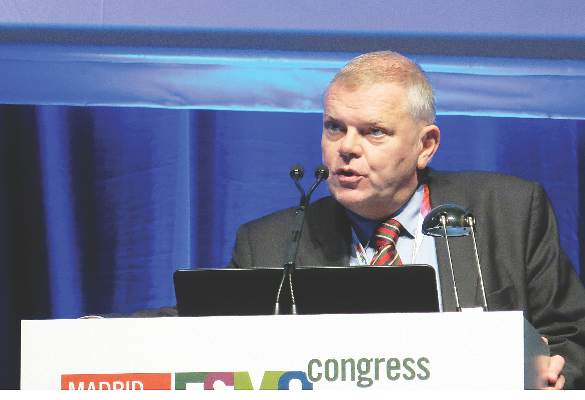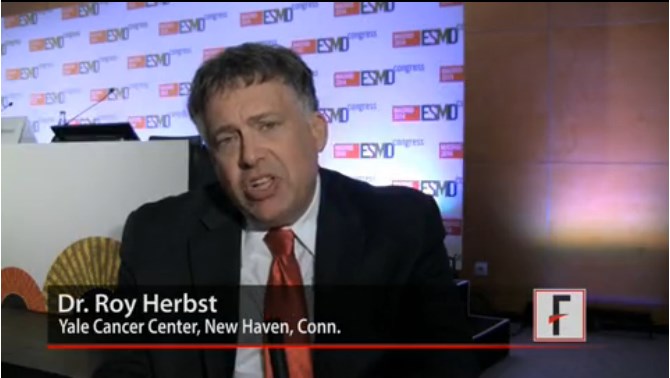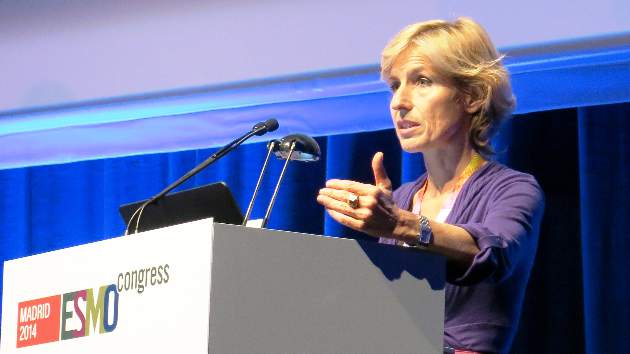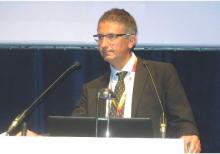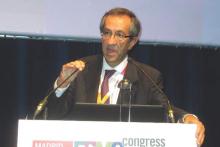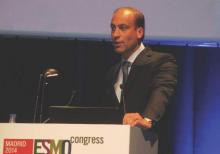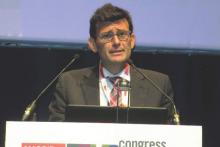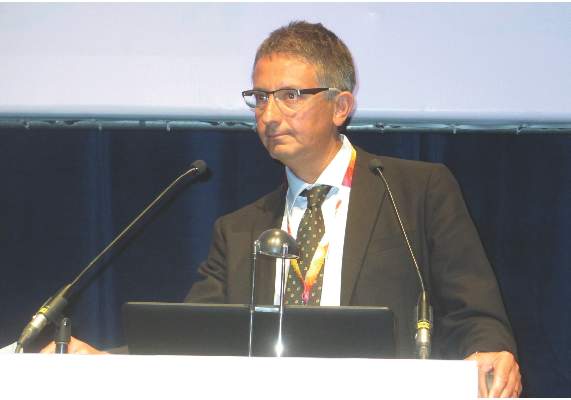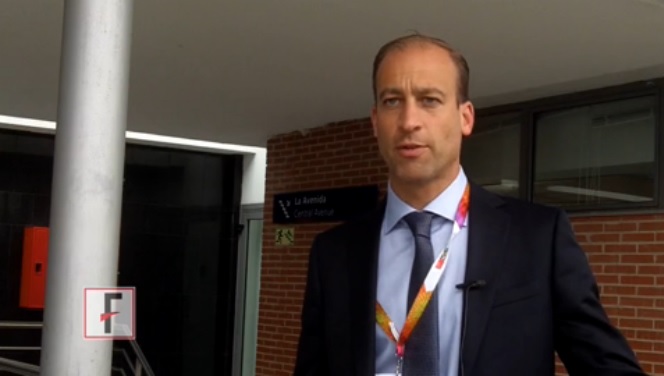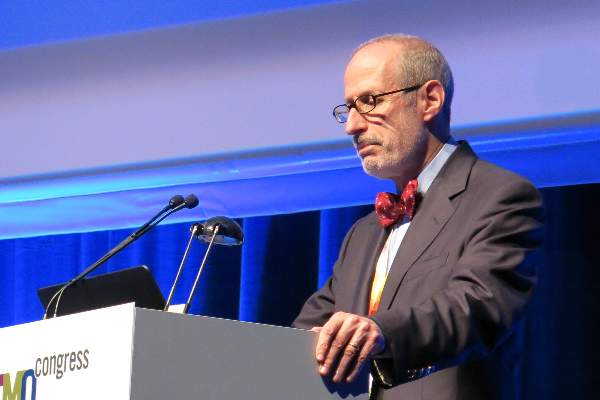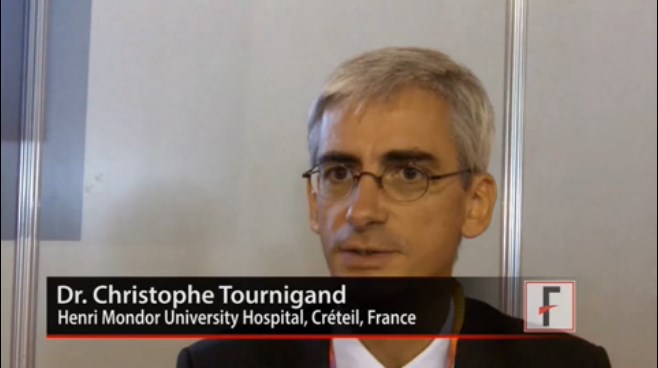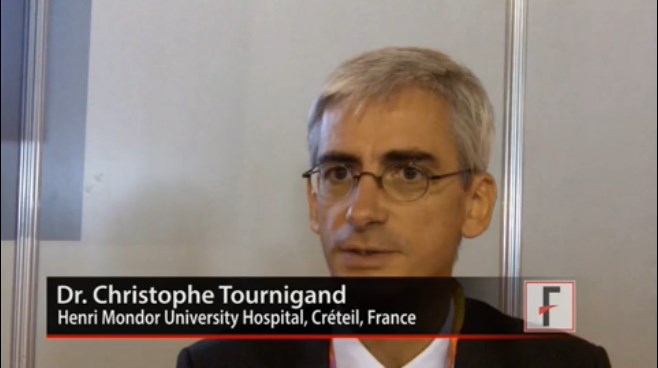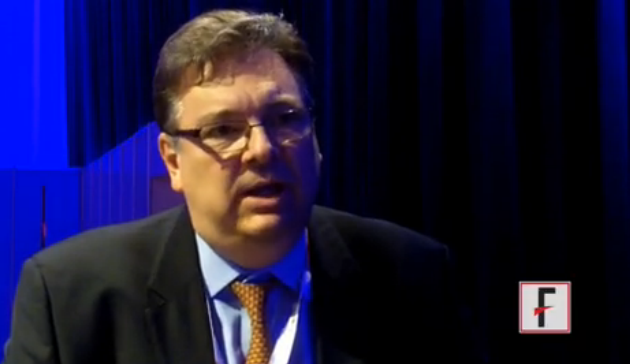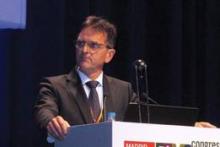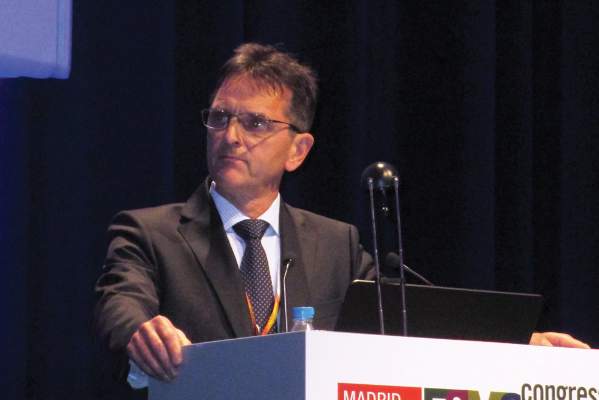User login
European Society for Medical Oncology (ESMO) 39th Congress
Adjuvant vaccine fails in NSCLC
MADRID – The future of lung cancer vaccines was dealt a strong blow with a full look at the disappointing phase III MAGRIT results.
Lead author Dr. Johan Vansteenkiste described adjuvant vaccination as a promising strategy that was formally tested in the appropriate disease setting with an adequately designed and powered trial.
“This means for me, that therapeutic vaccination with the current technology does not work in lung cancer,” he concluded in a presidential symposium at the annual congress of the European Society for Medical Oncology.
The MAGRIT (MAGE-A3 as Adjuvant Non–Small Cell Lung Cancer Immunotherapy) study assessed the efficacy of MAGE-A3 cancer immunotherapy (MAGE-A3 CI) in completely resected stage IB to IIIA non–small cell lung cancer (NSCLC) positive for melanoma-associated antigen 3 (MAGE-A3).
MAGE-A3 is not expressed in normal cells but is found in about a third of stage IB-IIIA non–small cell lung cancer and in a variety of other cancers. The vaccine, which contains a recombinant MAGE-A3 protein and a novel immunostimulant AS15, previously showed activity in a small study of resected lung cancer.
In MAGRIT, however, adjuvant MAGE-A3 CI failed to best placebo on the coprimary end points of disease-free survival in the overall population (median 60.5 vs. 57.9 months; hazard ratio, 1.02; P = .73) and in those without adjuvant chemotherapy (median 58.0 vs. 56.9 months; HR, 0.97; P = .75).
There was no benefit observed in any subset analysis, Dr. Vansteenkiste, from University Hospitals Leuven, Belgium, said.
Vaccine developer GlaxoSmithKline announced this spring that MAGRIT was being stopped after failing to meet its first and second coprimary end points and acknowledging that the third coprimary end point of identifying patients with a potentially predictive gene signature wasn’t feasible.
Although MAGE-A3 CI is dead in the water for NSCLC, GSK said in a statement it plans to continue to search for a predictive gene signature for the vaccine in patients with melanoma in the phase III DERMA trial.
MAGRIT randomized 2,272 patients 2:1 to 13 intramuscular injections of recombinant MAGE-A3 CI or placebo over 27 months, with or without up to 4 cycles of platinum-based chemotherapy. Overall, 52% of patients received adjuvant chemotherapy and 98% had a performance status of 0 or 1. The median age was 63 years.
Median overall survival was not reached in either arm, although on a positive note, the modern approach used in the global trial will likely result in an expected 5-year overall survival above 50% in both arms, Dr. Vansteenkiste said enthusiastically. Overall, MAGE-A3 CI was generally well tolerated.
Invited discussant Dr. George Coukos, director of the Ludwig Center in Lausanne, Switzerland, said future opportunities for vaccines in NSCLC may lie in autologous whole tumor antigen vaccines and in personalized molecular vaccines based on mutanome analysis.
Dr. Martin Reck, chief oncology physician, with Hospital Grosshansdorf, Germany, said in a statement that the MAGRIT results are disappointing and that “The concept of vaccination in lung cancer has to be questioned and checkpoint inhibition might be pursued instead.”
MADRID – The future of lung cancer vaccines was dealt a strong blow with a full look at the disappointing phase III MAGRIT results.
Lead author Dr. Johan Vansteenkiste described adjuvant vaccination as a promising strategy that was formally tested in the appropriate disease setting with an adequately designed and powered trial.
“This means for me, that therapeutic vaccination with the current technology does not work in lung cancer,” he concluded in a presidential symposium at the annual congress of the European Society for Medical Oncology.
The MAGRIT (MAGE-A3 as Adjuvant Non–Small Cell Lung Cancer Immunotherapy) study assessed the efficacy of MAGE-A3 cancer immunotherapy (MAGE-A3 CI) in completely resected stage IB to IIIA non–small cell lung cancer (NSCLC) positive for melanoma-associated antigen 3 (MAGE-A3).
MAGE-A3 is not expressed in normal cells but is found in about a third of stage IB-IIIA non–small cell lung cancer and in a variety of other cancers. The vaccine, which contains a recombinant MAGE-A3 protein and a novel immunostimulant AS15, previously showed activity in a small study of resected lung cancer.
In MAGRIT, however, adjuvant MAGE-A3 CI failed to best placebo on the coprimary end points of disease-free survival in the overall population (median 60.5 vs. 57.9 months; hazard ratio, 1.02; P = .73) and in those without adjuvant chemotherapy (median 58.0 vs. 56.9 months; HR, 0.97; P = .75).
There was no benefit observed in any subset analysis, Dr. Vansteenkiste, from University Hospitals Leuven, Belgium, said.
Vaccine developer GlaxoSmithKline announced this spring that MAGRIT was being stopped after failing to meet its first and second coprimary end points and acknowledging that the third coprimary end point of identifying patients with a potentially predictive gene signature wasn’t feasible.
Although MAGE-A3 CI is dead in the water for NSCLC, GSK said in a statement it plans to continue to search for a predictive gene signature for the vaccine in patients with melanoma in the phase III DERMA trial.
MAGRIT randomized 2,272 patients 2:1 to 13 intramuscular injections of recombinant MAGE-A3 CI or placebo over 27 months, with or without up to 4 cycles of platinum-based chemotherapy. Overall, 52% of patients received adjuvant chemotherapy and 98% had a performance status of 0 or 1. The median age was 63 years.
Median overall survival was not reached in either arm, although on a positive note, the modern approach used in the global trial will likely result in an expected 5-year overall survival above 50% in both arms, Dr. Vansteenkiste said enthusiastically. Overall, MAGE-A3 CI was generally well tolerated.
Invited discussant Dr. George Coukos, director of the Ludwig Center in Lausanne, Switzerland, said future opportunities for vaccines in NSCLC may lie in autologous whole tumor antigen vaccines and in personalized molecular vaccines based on mutanome analysis.
Dr. Martin Reck, chief oncology physician, with Hospital Grosshansdorf, Germany, said in a statement that the MAGRIT results are disappointing and that “The concept of vaccination in lung cancer has to be questioned and checkpoint inhibition might be pursued instead.”
MADRID – The future of lung cancer vaccines was dealt a strong blow with a full look at the disappointing phase III MAGRIT results.
Lead author Dr. Johan Vansteenkiste described adjuvant vaccination as a promising strategy that was formally tested in the appropriate disease setting with an adequately designed and powered trial.
“This means for me, that therapeutic vaccination with the current technology does not work in lung cancer,” he concluded in a presidential symposium at the annual congress of the European Society for Medical Oncology.
The MAGRIT (MAGE-A3 as Adjuvant Non–Small Cell Lung Cancer Immunotherapy) study assessed the efficacy of MAGE-A3 cancer immunotherapy (MAGE-A3 CI) in completely resected stage IB to IIIA non–small cell lung cancer (NSCLC) positive for melanoma-associated antigen 3 (MAGE-A3).
MAGE-A3 is not expressed in normal cells but is found in about a third of stage IB-IIIA non–small cell lung cancer and in a variety of other cancers. The vaccine, which contains a recombinant MAGE-A3 protein and a novel immunostimulant AS15, previously showed activity in a small study of resected lung cancer.
In MAGRIT, however, adjuvant MAGE-A3 CI failed to best placebo on the coprimary end points of disease-free survival in the overall population (median 60.5 vs. 57.9 months; hazard ratio, 1.02; P = .73) and in those without adjuvant chemotherapy (median 58.0 vs. 56.9 months; HR, 0.97; P = .75).
There was no benefit observed in any subset analysis, Dr. Vansteenkiste, from University Hospitals Leuven, Belgium, said.
Vaccine developer GlaxoSmithKline announced this spring that MAGRIT was being stopped after failing to meet its first and second coprimary end points and acknowledging that the third coprimary end point of identifying patients with a potentially predictive gene signature wasn’t feasible.
Although MAGE-A3 CI is dead in the water for NSCLC, GSK said in a statement it plans to continue to search for a predictive gene signature for the vaccine in patients with melanoma in the phase III DERMA trial.
MAGRIT randomized 2,272 patients 2:1 to 13 intramuscular injections of recombinant MAGE-A3 CI or placebo over 27 months, with or without up to 4 cycles of platinum-based chemotherapy. Overall, 52% of patients received adjuvant chemotherapy and 98% had a performance status of 0 or 1. The median age was 63 years.
Median overall survival was not reached in either arm, although on a positive note, the modern approach used in the global trial will likely result in an expected 5-year overall survival above 50% in both arms, Dr. Vansteenkiste said enthusiastically. Overall, MAGE-A3 CI was generally well tolerated.
Invited discussant Dr. George Coukos, director of the Ludwig Center in Lausanne, Switzerland, said future opportunities for vaccines in NSCLC may lie in autologous whole tumor antigen vaccines and in personalized molecular vaccines based on mutanome analysis.
Dr. Martin Reck, chief oncology physician, with Hospital Grosshansdorf, Germany, said in a statement that the MAGRIT results are disappointing and that “The concept of vaccination in lung cancer has to be questioned and checkpoint inhibition might be pursued instead.”
AT ESMO 2014
Key clinical point: Adjuvant lung cancer vaccination failed to improve disease-free survival in early-stage non–small cell lung cancer.
Major finding: Disease-free survival was nearly identical with adjuvant MAGE-A3 CI and placebo in the overall population (median 60.5 months vs. 57.9 months; HR, 1.02; P = .73) and in patients without adjuvant chemotherapy (median 58.0 months vs. 56.9 months; HR, 0.97; P = .75).
Data source: Double-blind phase III study in 2,272 patients with resected MAGE-A3–positive non–small cell lung cancer.
Disclosures: GlaxoSmithKline Biologicals SA funded the study. Dr. Vansteenkiste reported fees from GSK as the primary investigator for MAGRIT. Dr. Coukos reported no conflicting interests.
VIDEO: Lung-MAP charts new ground in trial design
MADRID – Evaluating one new oncology drug is hard enough, but a novel collaborative clinical trial is taking on the task of testing five experimental drugs at once.
The Lung-MAP trial is using genomic profiling to direct patients to one of five simultaneous sub-studies that best fits their tumor’s genomic profile.
The treatments are for second-line, recurrent squamous cell lung cancer, an area of tremendous unmet need, according to Dr. Roy Herbst, chair of the Lung-MAP steering committee and chief of medical oncology at the Yale Cancer Center, New Haven, Conn.
The novel design of the phase II/III trial should speed up assessment and approval of investigational drugs, and improve the likelihood that patients from the most highly academic to the most rural community sites will receive a targeted therapy.
“It’s really open throughout the country and that makes me very proud that we’re bringing molecular profiling and new drugs to patients of all resource levels,” Dr. Herbst said.
Watch our interview with Dr. Herbst at the annual congress of the European Society for Clinical Oncology, where he spoke about Lung-MAP in a special session on new clinical trial designs.
LungMAP is sponsored by the Southwest Oncology Group with collaboration from several public and private partners including the National Cancer Institute.
Groups interested in participating in Lung-MAP can contact Lung-MAP protocol coordinator Crystal Miwa at [email protected] or Dr. Herbst at [email protected].
Details on the protocol are also available at clinicaltrials.gov or the Lung-MAP website.
Dr. Herbst reported serving on the science advisory board of Biothera, DiaTech Oncology, Koltan, and N of One.
The video associated with this article is no longer available on this site. Please view all of our videos on the MDedge YouTube channel
MADRID – Evaluating one new oncology drug is hard enough, but a novel collaborative clinical trial is taking on the task of testing five experimental drugs at once.
The Lung-MAP trial is using genomic profiling to direct patients to one of five simultaneous sub-studies that best fits their tumor’s genomic profile.
The treatments are for second-line, recurrent squamous cell lung cancer, an area of tremendous unmet need, according to Dr. Roy Herbst, chair of the Lung-MAP steering committee and chief of medical oncology at the Yale Cancer Center, New Haven, Conn.
The novel design of the phase II/III trial should speed up assessment and approval of investigational drugs, and improve the likelihood that patients from the most highly academic to the most rural community sites will receive a targeted therapy.
“It’s really open throughout the country and that makes me very proud that we’re bringing molecular profiling and new drugs to patients of all resource levels,” Dr. Herbst said.
Watch our interview with Dr. Herbst at the annual congress of the European Society for Clinical Oncology, where he spoke about Lung-MAP in a special session on new clinical trial designs.
LungMAP is sponsored by the Southwest Oncology Group with collaboration from several public and private partners including the National Cancer Institute.
Groups interested in participating in Lung-MAP can contact Lung-MAP protocol coordinator Crystal Miwa at [email protected] or Dr. Herbst at [email protected].
Details on the protocol are also available at clinicaltrials.gov or the Lung-MAP website.
Dr. Herbst reported serving on the science advisory board of Biothera, DiaTech Oncology, Koltan, and N of One.
The video associated with this article is no longer available on this site. Please view all of our videos on the MDedge YouTube channel
MADRID – Evaluating one new oncology drug is hard enough, but a novel collaborative clinical trial is taking on the task of testing five experimental drugs at once.
The Lung-MAP trial is using genomic profiling to direct patients to one of five simultaneous sub-studies that best fits their tumor’s genomic profile.
The treatments are for second-line, recurrent squamous cell lung cancer, an area of tremendous unmet need, according to Dr. Roy Herbst, chair of the Lung-MAP steering committee and chief of medical oncology at the Yale Cancer Center, New Haven, Conn.
The novel design of the phase II/III trial should speed up assessment and approval of investigational drugs, and improve the likelihood that patients from the most highly academic to the most rural community sites will receive a targeted therapy.
“It’s really open throughout the country and that makes me very proud that we’re bringing molecular profiling and new drugs to patients of all resource levels,” Dr. Herbst said.
Watch our interview with Dr. Herbst at the annual congress of the European Society for Clinical Oncology, where he spoke about Lung-MAP in a special session on new clinical trial designs.
LungMAP is sponsored by the Southwest Oncology Group with collaboration from several public and private partners including the National Cancer Institute.
Groups interested in participating in Lung-MAP can contact Lung-MAP protocol coordinator Crystal Miwa at [email protected] or Dr. Herbst at [email protected].
Details on the protocol are also available at clinicaltrials.gov or the Lung-MAP website.
Dr. Herbst reported serving on the science advisory board of Biothera, DiaTech Oncology, Koltan, and N of One.
The video associated with this article is no longer available on this site. Please view all of our videos on the MDedge YouTube channel
AT ESMO 2014
COMBI-v affirms combination MEK, BRAF blockade in melanoma
MADRID – More complete blockade of the MAP kinase pathway with both a BRAF and MEK inhibitor decreased the risk of death by one-third among patients with advanced BRAF mutation–positive melanoma in the phase III COMBI-v study.
After a median follow-up of 10-11 months, the primary endpoint of overall survival was 17.2 months with the BRAF inhibitor vemurafenib (Zelboraf) alone, but had not been reached with the combination of the BRAF inhibitor dabrafenib (Tafinlar) and the MEK inhibitor trametinib (Mekinist) (hazard ratio, 0.69; P = .005).
“This combination has met all the endpoints that were looked for, and I’d like to remind you that we compared this combination to an already very active drug,” study author Dr. Caroline Robert, head of dermatology at the Institut Gustave Roussy in Paris, said during a presidential session at the European Society for Medical Oncology Congress.
Patients in the combination arm had significantly better median progression-free survival than those given vemurafenib monotherapy (11.4 vs. 7.3 months; HR, 0.56; P < .001), as well as higher response rates (64% vs. 51%; P < .001), more complete responses (13% vs. 8%), and a longer duration of response (13.8 vs. 7.5 months).
COMBI-v was stopped early for efficacy at the interim analysis, which de facto became the final overall survival analysis presented by Dr. Robert.
The study evenly randomized 704 patients with stage IIIC or IV BRAF V600E or V600K mutation–positive melanoma to first-line therapy with twice-daily dabrafenib 150 mg plus daily trametinib 2 mg or twice-daily vemurafenib 960 mg.
The study sponsor, GlaxoSmithKline, gained accelerated approval in the United States in January 2014 for use of combination dabrafenib and trametinib in unresectable BRAF V600E or V600K mutation–positive melanoma based on positive response data.
The strategy of up-front BRAF and MEK inhibition in BRAF-mutant unresectable disease was supported by data presented in the same session from the coBRIM study, where treatment with vemurafenib and the investigational MEK inhibitor cobimetinib improved progression-free survival, response rates, and overall survival, although the overall survival data are immature. Listen to our interview with coBRIM study author Dr. Grant McArthur.
Dr. Christian Blank, from the Netherlands Cancer Institute in Amsterdam, who was invited to discuss both studies, commented that the combinations used in COMBI-v and coBRIM had similar toxicity to that of single-agent treatment, and that if mature data confirm the presented observations, combined BRAF and MEK inhibition is the new standard therapy for patients with BRAF V600 melanoma.
In COMBI-v, patients receiving dabrafenib plus trametinib, as compared with vemurafenib alone, had more pyrexia (53% vs. 21%), chills (31% vs. 8%), and decreases in ejection fraction (8% vs. 0%), although the latter was easily reversible without sequelae, Dr. Robert stressed. The addition of a MEK inhibitor, however, reduced BRAF inhibitor–related adverse skin events such as cutaneous squamous cell carcinoma and keratoacanthoma (1% vs. 18%), as well as photosensitivity (4% vs. 36%).
GlaxoSmithKline funded the study. Dr. Robert reported serving as a consultant to GlaxoSmithKline, Roche, Bristol-Myers Squibb, Amgen, Novartis, and Merck. Dr. Blank disclosed an advisory role with GSK, Roche, BMS, MSD, and Novartis, honoraria from GSK, Roche, BMS, and MSD, and a research grant from Novartis.
MADRID – More complete blockade of the MAP kinase pathway with both a BRAF and MEK inhibitor decreased the risk of death by one-third among patients with advanced BRAF mutation–positive melanoma in the phase III COMBI-v study.
After a median follow-up of 10-11 months, the primary endpoint of overall survival was 17.2 months with the BRAF inhibitor vemurafenib (Zelboraf) alone, but had not been reached with the combination of the BRAF inhibitor dabrafenib (Tafinlar) and the MEK inhibitor trametinib (Mekinist) (hazard ratio, 0.69; P = .005).
“This combination has met all the endpoints that were looked for, and I’d like to remind you that we compared this combination to an already very active drug,” study author Dr. Caroline Robert, head of dermatology at the Institut Gustave Roussy in Paris, said during a presidential session at the European Society for Medical Oncology Congress.
Patients in the combination arm had significantly better median progression-free survival than those given vemurafenib monotherapy (11.4 vs. 7.3 months; HR, 0.56; P < .001), as well as higher response rates (64% vs. 51%; P < .001), more complete responses (13% vs. 8%), and a longer duration of response (13.8 vs. 7.5 months).
COMBI-v was stopped early for efficacy at the interim analysis, which de facto became the final overall survival analysis presented by Dr. Robert.
The study evenly randomized 704 patients with stage IIIC or IV BRAF V600E or V600K mutation–positive melanoma to first-line therapy with twice-daily dabrafenib 150 mg plus daily trametinib 2 mg or twice-daily vemurafenib 960 mg.
The study sponsor, GlaxoSmithKline, gained accelerated approval in the United States in January 2014 for use of combination dabrafenib and trametinib in unresectable BRAF V600E or V600K mutation–positive melanoma based on positive response data.
The strategy of up-front BRAF and MEK inhibition in BRAF-mutant unresectable disease was supported by data presented in the same session from the coBRIM study, where treatment with vemurafenib and the investigational MEK inhibitor cobimetinib improved progression-free survival, response rates, and overall survival, although the overall survival data are immature. Listen to our interview with coBRIM study author Dr. Grant McArthur.
Dr. Christian Blank, from the Netherlands Cancer Institute in Amsterdam, who was invited to discuss both studies, commented that the combinations used in COMBI-v and coBRIM had similar toxicity to that of single-agent treatment, and that if mature data confirm the presented observations, combined BRAF and MEK inhibition is the new standard therapy for patients with BRAF V600 melanoma.
In COMBI-v, patients receiving dabrafenib plus trametinib, as compared with vemurafenib alone, had more pyrexia (53% vs. 21%), chills (31% vs. 8%), and decreases in ejection fraction (8% vs. 0%), although the latter was easily reversible without sequelae, Dr. Robert stressed. The addition of a MEK inhibitor, however, reduced BRAF inhibitor–related adverse skin events such as cutaneous squamous cell carcinoma and keratoacanthoma (1% vs. 18%), as well as photosensitivity (4% vs. 36%).
GlaxoSmithKline funded the study. Dr. Robert reported serving as a consultant to GlaxoSmithKline, Roche, Bristol-Myers Squibb, Amgen, Novartis, and Merck. Dr. Blank disclosed an advisory role with GSK, Roche, BMS, MSD, and Novartis, honoraria from GSK, Roche, BMS, and MSD, and a research grant from Novartis.
MADRID – More complete blockade of the MAP kinase pathway with both a BRAF and MEK inhibitor decreased the risk of death by one-third among patients with advanced BRAF mutation–positive melanoma in the phase III COMBI-v study.
After a median follow-up of 10-11 months, the primary endpoint of overall survival was 17.2 months with the BRAF inhibitor vemurafenib (Zelboraf) alone, but had not been reached with the combination of the BRAF inhibitor dabrafenib (Tafinlar) and the MEK inhibitor trametinib (Mekinist) (hazard ratio, 0.69; P = .005).
“This combination has met all the endpoints that were looked for, and I’d like to remind you that we compared this combination to an already very active drug,” study author Dr. Caroline Robert, head of dermatology at the Institut Gustave Roussy in Paris, said during a presidential session at the European Society for Medical Oncology Congress.
Patients in the combination arm had significantly better median progression-free survival than those given vemurafenib monotherapy (11.4 vs. 7.3 months; HR, 0.56; P < .001), as well as higher response rates (64% vs. 51%; P < .001), more complete responses (13% vs. 8%), and a longer duration of response (13.8 vs. 7.5 months).
COMBI-v was stopped early for efficacy at the interim analysis, which de facto became the final overall survival analysis presented by Dr. Robert.
The study evenly randomized 704 patients with stage IIIC or IV BRAF V600E or V600K mutation–positive melanoma to first-line therapy with twice-daily dabrafenib 150 mg plus daily trametinib 2 mg or twice-daily vemurafenib 960 mg.
The study sponsor, GlaxoSmithKline, gained accelerated approval in the United States in January 2014 for use of combination dabrafenib and trametinib in unresectable BRAF V600E or V600K mutation–positive melanoma based on positive response data.
The strategy of up-front BRAF and MEK inhibition in BRAF-mutant unresectable disease was supported by data presented in the same session from the coBRIM study, where treatment with vemurafenib and the investigational MEK inhibitor cobimetinib improved progression-free survival, response rates, and overall survival, although the overall survival data are immature. Listen to our interview with coBRIM study author Dr. Grant McArthur.
Dr. Christian Blank, from the Netherlands Cancer Institute in Amsterdam, who was invited to discuss both studies, commented that the combinations used in COMBI-v and coBRIM had similar toxicity to that of single-agent treatment, and that if mature data confirm the presented observations, combined BRAF and MEK inhibition is the new standard therapy for patients with BRAF V600 melanoma.
In COMBI-v, patients receiving dabrafenib plus trametinib, as compared with vemurafenib alone, had more pyrexia (53% vs. 21%), chills (31% vs. 8%), and decreases in ejection fraction (8% vs. 0%), although the latter was easily reversible without sequelae, Dr. Robert stressed. The addition of a MEK inhibitor, however, reduced BRAF inhibitor–related adverse skin events such as cutaneous squamous cell carcinoma and keratoacanthoma (1% vs. 18%), as well as photosensitivity (4% vs. 36%).
GlaxoSmithKline funded the study. Dr. Robert reported serving as a consultant to GlaxoSmithKline, Roche, Bristol-Myers Squibb, Amgen, Novartis, and Merck. Dr. Blank disclosed an advisory role with GSK, Roche, BMS, MSD, and Novartis, honoraria from GSK, Roche, BMS, and MSD, and a research grant from Novartis.
AT ESMO 2014
Key clinical point: A BRAF and MEK inhibitor combination has greater efficacy than a BRAF inhibitor alone in BRAF mutation–positive melanoma.
Major finding: Overall survival was 17.2 months with vemurafenib alone, but had not been reached with combination dabrafenib and trametinib (hazard ratio, 0.69; P = .005).
Data source: Open-label, phase III study in 704 patients with advanced melanoma.
Disclosures: GlaxoSmithKline funded the study. Dr. Robert reported serving as a consultant to GlaxoSmithKline, Roche, Bristol-Myers Squibb, Amgen, Novartis, and Merck. Dr. Blank disclosed an advisory role with GSK, Roche, BMS, MSD and Novartis, honoraria from GSK, Roche, BMS, and MSD, and a research grant from Novartis.
Liquid biopsies: High potential but are they ready for prime time?
MADRID – Liquid biopsies to track genetic changes in a patient’s tumor by serial blood specimens rather than multiple tissue biopsies seem poised to enter routine clinical use. But several experts speaking at a session on the topic agreed that liquid biopsy technologies largely remain too unproven to enter everyday practice right now.
“I have no doubt [liquid biopsy] will become routine, but right now the evidence is lacking,” said Alberto Bardelli, Ph.D., summarizing a session he cochaired at the European Society for Medical Oncology Congress.
“I think the potential is very high to use liquid biopsy to monitor residual disease in patients with breast cancer or other tumor types. There is also the possibility of using CTCs [circulating tumor cells] to interrogate the genome of single tumor cells or to grow the cells and use them functionally” to, for example, help identify effective treatments against the tumor, said Dr. Bardelli, a molecular biologist at the University of Torino, Italy.
Liquid biopsies are generally divided into two categories. One approach involves the isolation and analysis of individual, living tumor cells that slough off a primary tumor or metastasis and can be isolated from a patient’s peripheral blood, although tumor cell concentrations are very low, on the order of one tumor cell in a million normal blood cells or even 10- to 100-fold more dilute than that.
In 2004, the Food and Drug Administration approved CellSearch, a commercial test that quantifies CTCs in patients with metastatic breast cancer to predict the likelihood of survival. CellSearch remains the only FDA-approved liquid biopsy assay for cancer, though its use has expanded to patients with prostate or colorectal cancer as well as breast cancer.
Circulating tumor DNA
The second option is to isolate and analyze the DNA that slips out of dead tumor cells and enters a patient’s circulation. One advantage of focusing on circulating tumor DNA (ctDNA) is that it is more than 100 times as common in a patent’s blood as tumor cells; however, tumor DNA is limited to providing a broad-brush average of what is going on genetically in a primary tumor and its metastases at any time, rather than giving the specificity of a genome isolated from a single, circulating tumor cell.
Both approaches seem to have value, and both seem on course to continue in development and be used in complementary ways.
An example of the potential benefit of analyzing ctDNA came in a study published last year, in which investigators identified genetic alterations that they could use to follow patients with metastatic breast cancer. They found ctDNA in the blood of 29 out of 52 women, and saw a strong, inverse relationship between increased levels of ctDNA and survival. Patients with a below-average level of ctDNA had significantly better survival, while patients with relatively higher ctDNA levels had significantly worse survival, the British researchers reported last year (New Engl. J. Med. 2013;368:1199-209). The study results also showed that quantifying ctDNA provided better correlation with changes in tumor burden than did quantifying CTCs or measuring an immune marker for breast cancer, CA 15-3.
More recently, these investigators expanded the mutation panel they use to identify ctDNA, and now can find a single-nucleotide or structural variant in the DNAs of 48 of these 52 patients, Dr. Carlos Caldas, one of the investigators, said in a talk at the meeting. Dr. Caldas added that he and his associates have now seen a patient from this series with triple-negative breast cancer and an elevated level of ctDNA who then showed a dramatic reduction in ctDNA level following several treatment cycles. This drop in ctDNA level tracked with the patient’s complete pathological response to treatment.
“This is preliminary evidence that you can use ctDNA as a very early marker of treatment response,” said Dr. Caldas, professor of cancer medicine at the University of Cambridge, England.
Other advantages of measuring ctDNA, especially compared with tracking a tumor using CTCs, is that it is simple and relatively inexpensive, with no need for special isolation technology, and it reflects the patient’s total tumor burden, noted Dr. Gerald Prager, an oncologist at the Medical University of Vienna. He cited a recent example of the power of ctDNA analysis in a report on 106 patients with colorectal cancer, who underwent ctDNA analysis for KRAS and BRAF mutations. Comparison of results from the ctDNA analysis and conventional mutation determinations showed 100% sensitivity and specificity for detecting tumors with the BRAF V600E mutation, and 98% specificity and 92% sensitivity for detecting any of seven KRAS point mutations (Nature Med. 2014;20:430-5).
“We think that liquid biopsies can help deliver the right treatment to a patient at the right time, and less invasively” than tissue biopsies, Dr. Prager said in a talk at the meeting. “They are useful for monitoring tumor growth and therapeutic activity.” He and his associates now have a study in progress evaluating the ability of serial ctDNA analysis to improve treatment with regorafenib in patients with metastatic colorectal cancer.
Analyses using ctDNA “are accurate, but we need to perform clinical trials to know what we should do with the information,” Dr. Prager said in an interview. “When we see a clone has been selected, should we change treatment before we see actual disease progression? This question has not yet been answered,” he said.
Circulating tumor cells
Liquid biopsy for CTCs has the advantage over ctDNA of having an FDA-approved test, which uses epithelial-marker antigens on the surface of CTCs to isolate the cells from a 7.5-mL specimen of blood. Study results showed a clear link between increased numbers of CTCs in patients and their rate of metastatic progression. For example, a meta-analysis published this year summarized data on CTC analysis in 1,944 patients with metastatic breast cancer evaluated in 20 separate studies done at 17 European centers. This meta-analysis showed that 47% of patients had a CTC count at baseline of 5 cells or more in a 7.5-mL specimen, and that this was significantly linked to diminished overall survival (hazard ratio, 1.92; 95% confidence interval, 1.73-2.14; P < .0001) (Lancet Oncol. 2014;15:406-14). The data also showed significantly reduced survival when CTC count increased either 3-5 weeks after treatment started or 6-8 weeks after treatment started. All these findings “confirm the independent, prognostic effect of CTC count on progression-free survival and overall survival,” the authors concluded.
This report confirmed the added value of CTC number, which was first reported using the same CellSearch technology a decade before (New Engl. J. Med. 2004;351:781-91).
The 2014 meta-analysis “provides level I evidence that CTC detection with CellSearch is an adverse prognostic factor in metastatic breast cancer,” said Dr. Michail Ignatiadis, an oncologist at the Jules Bordet Institute in Brussels.
But while CTC number “gives us very good prognostication, what we want is to know whether a treatment is working, and [whether we] can we get enough information from these cells to decide on what treatment to use. That is more challenging,” said Dr. Klaus Pantel, a professor of oncology and director of tumor biology at the University of Hamburg, Germany.
“We can now say, by monitoring CTCs in blood, whether or not treatment is going in the right direction; and it is important to have an early indicator of treatment response, but the challenge is to get a good picture” of the tumor to guide drug selection, Dr. Pantel said in an interview. He has recently used a new approach to collect CTCs developed by Gilupi that employs a receptor-coated needle placed in a patient’s blood vessel and left there for 30 minutes, during which roughly a liter of blood passes by the needle, allowing for collection of many more CTCs than is possible from a 7.5-mL specimen.
Another question about CTCs is that collection works well in metastatic-stage disease, when CTCs are relatively plentiful, but can it also play a role in assessing mortality risk in patients with early-stage cancer? Dr. Pantel and his associates recently addressed this question by using the CellSearch assay in 2,026 patients with early-stage breast cancer prior to treatment with adjuvant chemotherapy, and 1,492 patients after chemotherapy. The results showed that the presence of CTCs was linked to worse prognosis, with the worst outcomes occurring in women with 5 or more CTCs in 30 mL of blood (J. Natl. Cancer Inst. 2014;106:dju066 [doi: 10.1093/jnci/dju066]). The findings are the first “to provide strong evidence for the prognostic relevance of CTCs in early breast cancer before and after adjuvant chemotherapy in a large patient cohort,” Dr. Pantel and his coauthors concluded. “Our data offer support for the clinical potential of CTCs to assess the individual risk of patients at the time of primary diagnosis.”
Coupling liquid biopsies with better treatments
One of the challenges of using liquid biopsies to improve cancer treatment is the inherent limitation researchers often encounter of having to rely on inadequate treatment regimens with limited efficacy, Dr. Ignatiadis noted. That limitation came into play in a recent report of a study that used CTCs to stratify risk in patients with metastatic breast cancer and randomize them to either of two different treatment regimens. The results confirmed the prognostic significance of CTC number but failed to show that changing treatment based on CTC number improved outcomes, likely because the alternative regimen applied offered no real advantages over the comparator, the researchers concluded (J. Clin. Oncol. 2014 June 2 [doi: 10.1200/JCO.2014.56.2561]).
Studies now in progress have been designed to specifically test the efficacy of new treatment approaches in cancer populations selected for their CTC or ctDNA profile, such as the TREAT CTC trial, which is evaluating the efficacy of trastuzumab for treating women with detectable CTCs and HER2-negative primary breast cancer. Another example is the DETECT III trial, which is investigating the efficacy of lapatinib in patients with metastatic breast cancer who have HER2-positive CTCs.
“Until now we have mostly had proof-of-principle studies. Now we need to see how CTCs and ctDNA work in real practice” and in coordination with new approaches to treatment, Dr. Pantel said.
Dr. Bardelli is a shareholder in Horizon Discovery and has been an adviser to Biocartis, Trovagene, and HD. Dr. Caldas had no disclosures. Dr. Prager has been an adviser and consultant to Bayer, Roche, Amgen, Merck Serono, and Sanofi-Aventis. Dr. Ignatiadis has received educational grants from Janssen Diagnostics and Roche. Dr. Pantel has been an adviser to Veridex/Janssen, Alere, and Gilupi.
On Twitter @mitchelzoler
MADRID – Liquid biopsies to track genetic changes in a patient’s tumor by serial blood specimens rather than multiple tissue biopsies seem poised to enter routine clinical use. But several experts speaking at a session on the topic agreed that liquid biopsy technologies largely remain too unproven to enter everyday practice right now.
“I have no doubt [liquid biopsy] will become routine, but right now the evidence is lacking,” said Alberto Bardelli, Ph.D., summarizing a session he cochaired at the European Society for Medical Oncology Congress.
“I think the potential is very high to use liquid biopsy to monitor residual disease in patients with breast cancer or other tumor types. There is also the possibility of using CTCs [circulating tumor cells] to interrogate the genome of single tumor cells or to grow the cells and use them functionally” to, for example, help identify effective treatments against the tumor, said Dr. Bardelli, a molecular biologist at the University of Torino, Italy.
Liquid biopsies are generally divided into two categories. One approach involves the isolation and analysis of individual, living tumor cells that slough off a primary tumor or metastasis and can be isolated from a patient’s peripheral blood, although tumor cell concentrations are very low, on the order of one tumor cell in a million normal blood cells or even 10- to 100-fold more dilute than that.
In 2004, the Food and Drug Administration approved CellSearch, a commercial test that quantifies CTCs in patients with metastatic breast cancer to predict the likelihood of survival. CellSearch remains the only FDA-approved liquid biopsy assay for cancer, though its use has expanded to patients with prostate or colorectal cancer as well as breast cancer.
Circulating tumor DNA
The second option is to isolate and analyze the DNA that slips out of dead tumor cells and enters a patient’s circulation. One advantage of focusing on circulating tumor DNA (ctDNA) is that it is more than 100 times as common in a patent’s blood as tumor cells; however, tumor DNA is limited to providing a broad-brush average of what is going on genetically in a primary tumor and its metastases at any time, rather than giving the specificity of a genome isolated from a single, circulating tumor cell.
Both approaches seem to have value, and both seem on course to continue in development and be used in complementary ways.
An example of the potential benefit of analyzing ctDNA came in a study published last year, in which investigators identified genetic alterations that they could use to follow patients with metastatic breast cancer. They found ctDNA in the blood of 29 out of 52 women, and saw a strong, inverse relationship between increased levels of ctDNA and survival. Patients with a below-average level of ctDNA had significantly better survival, while patients with relatively higher ctDNA levels had significantly worse survival, the British researchers reported last year (New Engl. J. Med. 2013;368:1199-209). The study results also showed that quantifying ctDNA provided better correlation with changes in tumor burden than did quantifying CTCs or measuring an immune marker for breast cancer, CA 15-3.
More recently, these investigators expanded the mutation panel they use to identify ctDNA, and now can find a single-nucleotide or structural variant in the DNAs of 48 of these 52 patients, Dr. Carlos Caldas, one of the investigators, said in a talk at the meeting. Dr. Caldas added that he and his associates have now seen a patient from this series with triple-negative breast cancer and an elevated level of ctDNA who then showed a dramatic reduction in ctDNA level following several treatment cycles. This drop in ctDNA level tracked with the patient’s complete pathological response to treatment.
“This is preliminary evidence that you can use ctDNA as a very early marker of treatment response,” said Dr. Caldas, professor of cancer medicine at the University of Cambridge, England.
Other advantages of measuring ctDNA, especially compared with tracking a tumor using CTCs, is that it is simple and relatively inexpensive, with no need for special isolation technology, and it reflects the patient’s total tumor burden, noted Dr. Gerald Prager, an oncologist at the Medical University of Vienna. He cited a recent example of the power of ctDNA analysis in a report on 106 patients with colorectal cancer, who underwent ctDNA analysis for KRAS and BRAF mutations. Comparison of results from the ctDNA analysis and conventional mutation determinations showed 100% sensitivity and specificity for detecting tumors with the BRAF V600E mutation, and 98% specificity and 92% sensitivity for detecting any of seven KRAS point mutations (Nature Med. 2014;20:430-5).
“We think that liquid biopsies can help deliver the right treatment to a patient at the right time, and less invasively” than tissue biopsies, Dr. Prager said in a talk at the meeting. “They are useful for monitoring tumor growth and therapeutic activity.” He and his associates now have a study in progress evaluating the ability of serial ctDNA analysis to improve treatment with regorafenib in patients with metastatic colorectal cancer.
Analyses using ctDNA “are accurate, but we need to perform clinical trials to know what we should do with the information,” Dr. Prager said in an interview. “When we see a clone has been selected, should we change treatment before we see actual disease progression? This question has not yet been answered,” he said.
Circulating tumor cells
Liquid biopsy for CTCs has the advantage over ctDNA of having an FDA-approved test, which uses epithelial-marker antigens on the surface of CTCs to isolate the cells from a 7.5-mL specimen of blood. Study results showed a clear link between increased numbers of CTCs in patients and their rate of metastatic progression. For example, a meta-analysis published this year summarized data on CTC analysis in 1,944 patients with metastatic breast cancer evaluated in 20 separate studies done at 17 European centers. This meta-analysis showed that 47% of patients had a CTC count at baseline of 5 cells or more in a 7.5-mL specimen, and that this was significantly linked to diminished overall survival (hazard ratio, 1.92; 95% confidence interval, 1.73-2.14; P < .0001) (Lancet Oncol. 2014;15:406-14). The data also showed significantly reduced survival when CTC count increased either 3-5 weeks after treatment started or 6-8 weeks after treatment started. All these findings “confirm the independent, prognostic effect of CTC count on progression-free survival and overall survival,” the authors concluded.
This report confirmed the added value of CTC number, which was first reported using the same CellSearch technology a decade before (New Engl. J. Med. 2004;351:781-91).
The 2014 meta-analysis “provides level I evidence that CTC detection with CellSearch is an adverse prognostic factor in metastatic breast cancer,” said Dr. Michail Ignatiadis, an oncologist at the Jules Bordet Institute in Brussels.
But while CTC number “gives us very good prognostication, what we want is to know whether a treatment is working, and [whether we] can we get enough information from these cells to decide on what treatment to use. That is more challenging,” said Dr. Klaus Pantel, a professor of oncology and director of tumor biology at the University of Hamburg, Germany.
“We can now say, by monitoring CTCs in blood, whether or not treatment is going in the right direction; and it is important to have an early indicator of treatment response, but the challenge is to get a good picture” of the tumor to guide drug selection, Dr. Pantel said in an interview. He has recently used a new approach to collect CTCs developed by Gilupi that employs a receptor-coated needle placed in a patient’s blood vessel and left there for 30 minutes, during which roughly a liter of blood passes by the needle, allowing for collection of many more CTCs than is possible from a 7.5-mL specimen.
Another question about CTCs is that collection works well in metastatic-stage disease, when CTCs are relatively plentiful, but can it also play a role in assessing mortality risk in patients with early-stage cancer? Dr. Pantel and his associates recently addressed this question by using the CellSearch assay in 2,026 patients with early-stage breast cancer prior to treatment with adjuvant chemotherapy, and 1,492 patients after chemotherapy. The results showed that the presence of CTCs was linked to worse prognosis, with the worst outcomes occurring in women with 5 or more CTCs in 30 mL of blood (J. Natl. Cancer Inst. 2014;106:dju066 [doi: 10.1093/jnci/dju066]). The findings are the first “to provide strong evidence for the prognostic relevance of CTCs in early breast cancer before and after adjuvant chemotherapy in a large patient cohort,” Dr. Pantel and his coauthors concluded. “Our data offer support for the clinical potential of CTCs to assess the individual risk of patients at the time of primary diagnosis.”
Coupling liquid biopsies with better treatments
One of the challenges of using liquid biopsies to improve cancer treatment is the inherent limitation researchers often encounter of having to rely on inadequate treatment regimens with limited efficacy, Dr. Ignatiadis noted. That limitation came into play in a recent report of a study that used CTCs to stratify risk in patients with metastatic breast cancer and randomize them to either of two different treatment regimens. The results confirmed the prognostic significance of CTC number but failed to show that changing treatment based on CTC number improved outcomes, likely because the alternative regimen applied offered no real advantages over the comparator, the researchers concluded (J. Clin. Oncol. 2014 June 2 [doi: 10.1200/JCO.2014.56.2561]).
Studies now in progress have been designed to specifically test the efficacy of new treatment approaches in cancer populations selected for their CTC or ctDNA profile, such as the TREAT CTC trial, which is evaluating the efficacy of trastuzumab for treating women with detectable CTCs and HER2-negative primary breast cancer. Another example is the DETECT III trial, which is investigating the efficacy of lapatinib in patients with metastatic breast cancer who have HER2-positive CTCs.
“Until now we have mostly had proof-of-principle studies. Now we need to see how CTCs and ctDNA work in real practice” and in coordination with new approaches to treatment, Dr. Pantel said.
Dr. Bardelli is a shareholder in Horizon Discovery and has been an adviser to Biocartis, Trovagene, and HD. Dr. Caldas had no disclosures. Dr. Prager has been an adviser and consultant to Bayer, Roche, Amgen, Merck Serono, and Sanofi-Aventis. Dr. Ignatiadis has received educational grants from Janssen Diagnostics and Roche. Dr. Pantel has been an adviser to Veridex/Janssen, Alere, and Gilupi.
On Twitter @mitchelzoler
MADRID – Liquid biopsies to track genetic changes in a patient’s tumor by serial blood specimens rather than multiple tissue biopsies seem poised to enter routine clinical use. But several experts speaking at a session on the topic agreed that liquid biopsy technologies largely remain too unproven to enter everyday practice right now.
“I have no doubt [liquid biopsy] will become routine, but right now the evidence is lacking,” said Alberto Bardelli, Ph.D., summarizing a session he cochaired at the European Society for Medical Oncology Congress.
“I think the potential is very high to use liquid biopsy to monitor residual disease in patients with breast cancer or other tumor types. There is also the possibility of using CTCs [circulating tumor cells] to interrogate the genome of single tumor cells or to grow the cells and use them functionally” to, for example, help identify effective treatments against the tumor, said Dr. Bardelli, a molecular biologist at the University of Torino, Italy.
Liquid biopsies are generally divided into two categories. One approach involves the isolation and analysis of individual, living tumor cells that slough off a primary tumor or metastasis and can be isolated from a patient’s peripheral blood, although tumor cell concentrations are very low, on the order of one tumor cell in a million normal blood cells or even 10- to 100-fold more dilute than that.
In 2004, the Food and Drug Administration approved CellSearch, a commercial test that quantifies CTCs in patients with metastatic breast cancer to predict the likelihood of survival. CellSearch remains the only FDA-approved liquid biopsy assay for cancer, though its use has expanded to patients with prostate or colorectal cancer as well as breast cancer.
Circulating tumor DNA
The second option is to isolate and analyze the DNA that slips out of dead tumor cells and enters a patient’s circulation. One advantage of focusing on circulating tumor DNA (ctDNA) is that it is more than 100 times as common in a patent’s blood as tumor cells; however, tumor DNA is limited to providing a broad-brush average of what is going on genetically in a primary tumor and its metastases at any time, rather than giving the specificity of a genome isolated from a single, circulating tumor cell.
Both approaches seem to have value, and both seem on course to continue in development and be used in complementary ways.
An example of the potential benefit of analyzing ctDNA came in a study published last year, in which investigators identified genetic alterations that they could use to follow patients with metastatic breast cancer. They found ctDNA in the blood of 29 out of 52 women, and saw a strong, inverse relationship between increased levels of ctDNA and survival. Patients with a below-average level of ctDNA had significantly better survival, while patients with relatively higher ctDNA levels had significantly worse survival, the British researchers reported last year (New Engl. J. Med. 2013;368:1199-209). The study results also showed that quantifying ctDNA provided better correlation with changes in tumor burden than did quantifying CTCs or measuring an immune marker for breast cancer, CA 15-3.
More recently, these investigators expanded the mutation panel they use to identify ctDNA, and now can find a single-nucleotide or structural variant in the DNAs of 48 of these 52 patients, Dr. Carlos Caldas, one of the investigators, said in a talk at the meeting. Dr. Caldas added that he and his associates have now seen a patient from this series with triple-negative breast cancer and an elevated level of ctDNA who then showed a dramatic reduction in ctDNA level following several treatment cycles. This drop in ctDNA level tracked with the patient’s complete pathological response to treatment.
“This is preliminary evidence that you can use ctDNA as a very early marker of treatment response,” said Dr. Caldas, professor of cancer medicine at the University of Cambridge, England.
Other advantages of measuring ctDNA, especially compared with tracking a tumor using CTCs, is that it is simple and relatively inexpensive, with no need for special isolation technology, and it reflects the patient’s total tumor burden, noted Dr. Gerald Prager, an oncologist at the Medical University of Vienna. He cited a recent example of the power of ctDNA analysis in a report on 106 patients with colorectal cancer, who underwent ctDNA analysis for KRAS and BRAF mutations. Comparison of results from the ctDNA analysis and conventional mutation determinations showed 100% sensitivity and specificity for detecting tumors with the BRAF V600E mutation, and 98% specificity and 92% sensitivity for detecting any of seven KRAS point mutations (Nature Med. 2014;20:430-5).
“We think that liquid biopsies can help deliver the right treatment to a patient at the right time, and less invasively” than tissue biopsies, Dr. Prager said in a talk at the meeting. “They are useful for monitoring tumor growth and therapeutic activity.” He and his associates now have a study in progress evaluating the ability of serial ctDNA analysis to improve treatment with regorafenib in patients with metastatic colorectal cancer.
Analyses using ctDNA “are accurate, but we need to perform clinical trials to know what we should do with the information,” Dr. Prager said in an interview. “When we see a clone has been selected, should we change treatment before we see actual disease progression? This question has not yet been answered,” he said.
Circulating tumor cells
Liquid biopsy for CTCs has the advantage over ctDNA of having an FDA-approved test, which uses epithelial-marker antigens on the surface of CTCs to isolate the cells from a 7.5-mL specimen of blood. Study results showed a clear link between increased numbers of CTCs in patients and their rate of metastatic progression. For example, a meta-analysis published this year summarized data on CTC analysis in 1,944 patients with metastatic breast cancer evaluated in 20 separate studies done at 17 European centers. This meta-analysis showed that 47% of patients had a CTC count at baseline of 5 cells or more in a 7.5-mL specimen, and that this was significantly linked to diminished overall survival (hazard ratio, 1.92; 95% confidence interval, 1.73-2.14; P < .0001) (Lancet Oncol. 2014;15:406-14). The data also showed significantly reduced survival when CTC count increased either 3-5 weeks after treatment started or 6-8 weeks after treatment started. All these findings “confirm the independent, prognostic effect of CTC count on progression-free survival and overall survival,” the authors concluded.
This report confirmed the added value of CTC number, which was first reported using the same CellSearch technology a decade before (New Engl. J. Med. 2004;351:781-91).
The 2014 meta-analysis “provides level I evidence that CTC detection with CellSearch is an adverse prognostic factor in metastatic breast cancer,” said Dr. Michail Ignatiadis, an oncologist at the Jules Bordet Institute in Brussels.
But while CTC number “gives us very good prognostication, what we want is to know whether a treatment is working, and [whether we] can we get enough information from these cells to decide on what treatment to use. That is more challenging,” said Dr. Klaus Pantel, a professor of oncology and director of tumor biology at the University of Hamburg, Germany.
“We can now say, by monitoring CTCs in blood, whether or not treatment is going in the right direction; and it is important to have an early indicator of treatment response, but the challenge is to get a good picture” of the tumor to guide drug selection, Dr. Pantel said in an interview. He has recently used a new approach to collect CTCs developed by Gilupi that employs a receptor-coated needle placed in a patient’s blood vessel and left there for 30 minutes, during which roughly a liter of blood passes by the needle, allowing for collection of many more CTCs than is possible from a 7.5-mL specimen.
Another question about CTCs is that collection works well in metastatic-stage disease, when CTCs are relatively plentiful, but can it also play a role in assessing mortality risk in patients with early-stage cancer? Dr. Pantel and his associates recently addressed this question by using the CellSearch assay in 2,026 patients with early-stage breast cancer prior to treatment with adjuvant chemotherapy, and 1,492 patients after chemotherapy. The results showed that the presence of CTCs was linked to worse prognosis, with the worst outcomes occurring in women with 5 or more CTCs in 30 mL of blood (J. Natl. Cancer Inst. 2014;106:dju066 [doi: 10.1093/jnci/dju066]). The findings are the first “to provide strong evidence for the prognostic relevance of CTCs in early breast cancer before and after adjuvant chemotherapy in a large patient cohort,” Dr. Pantel and his coauthors concluded. “Our data offer support for the clinical potential of CTCs to assess the individual risk of patients at the time of primary diagnosis.”
Coupling liquid biopsies with better treatments
One of the challenges of using liquid biopsies to improve cancer treatment is the inherent limitation researchers often encounter of having to rely on inadequate treatment regimens with limited efficacy, Dr. Ignatiadis noted. That limitation came into play in a recent report of a study that used CTCs to stratify risk in patients with metastatic breast cancer and randomize them to either of two different treatment regimens. The results confirmed the prognostic significance of CTC number but failed to show that changing treatment based on CTC number improved outcomes, likely because the alternative regimen applied offered no real advantages over the comparator, the researchers concluded (J. Clin. Oncol. 2014 June 2 [doi: 10.1200/JCO.2014.56.2561]).
Studies now in progress have been designed to specifically test the efficacy of new treatment approaches in cancer populations selected for their CTC or ctDNA profile, such as the TREAT CTC trial, which is evaluating the efficacy of trastuzumab for treating women with detectable CTCs and HER2-negative primary breast cancer. Another example is the DETECT III trial, which is investigating the efficacy of lapatinib in patients with metastatic breast cancer who have HER2-positive CTCs.
“Until now we have mostly had proof-of-principle studies. Now we need to see how CTCs and ctDNA work in real practice” and in coordination with new approaches to treatment, Dr. Pantel said.
Dr. Bardelli is a shareholder in Horizon Discovery and has been an adviser to Biocartis, Trovagene, and HD. Dr. Caldas had no disclosures. Dr. Prager has been an adviser and consultant to Bayer, Roche, Amgen, Merck Serono, and Sanofi-Aventis. Dr. Ignatiadis has received educational grants from Janssen Diagnostics and Roche. Dr. Pantel has been an adviser to Veridex/Janssen, Alere, and Gilupi.
On Twitter @mitchelzoler
EXPERT ANALYSIS FROM ESMO 2014
VIDEO: Liquid tumor biopsies await prospective validation
MADRID – Assessing the genetic profile of tumor DNA circulating in a cancer patient’s blood is a potentially attractive way to track a tumor without the need for multiple tissue biopsies. The limitation of these liquid biopsies is that the clinical relevance of periodically assessing circulating tumor DNA has not yet been proven, Dr. Gerald Prager said during a video interview at the European Society for Medical Oncology Congress.
“We need to perform clinical trials to know what to do” with the information that comes from evaluating circulating tumor DNA, said Dr. Prager, an oncologist at the Medical University of Vienna.
“Should we change” a patient’s treatment based on genetic results “before we see disease progression? We have not answered that yet.”
Dr. Prager has been an adviser and consultant to Bayer, Roche, Amgen, Merck Serono, and Sanofi-Aventis.
On Twitter @mitchelzoler
The video associated with this article is no longer available on this site. Please view all of our videos on the MDedge YouTube channel
MADRID – Assessing the genetic profile of tumor DNA circulating in a cancer patient’s blood is a potentially attractive way to track a tumor without the need for multiple tissue biopsies. The limitation of these liquid biopsies is that the clinical relevance of periodically assessing circulating tumor DNA has not yet been proven, Dr. Gerald Prager said during a video interview at the European Society for Medical Oncology Congress.
“We need to perform clinical trials to know what to do” with the information that comes from evaluating circulating tumor DNA, said Dr. Prager, an oncologist at the Medical University of Vienna.
“Should we change” a patient’s treatment based on genetic results “before we see disease progression? We have not answered that yet.”
Dr. Prager has been an adviser and consultant to Bayer, Roche, Amgen, Merck Serono, and Sanofi-Aventis.
On Twitter @mitchelzoler
The video associated with this article is no longer available on this site. Please view all of our videos on the MDedge YouTube channel
MADRID – Assessing the genetic profile of tumor DNA circulating in a cancer patient’s blood is a potentially attractive way to track a tumor without the need for multiple tissue biopsies. The limitation of these liquid biopsies is that the clinical relevance of periodically assessing circulating tumor DNA has not yet been proven, Dr. Gerald Prager said during a video interview at the European Society for Medical Oncology Congress.
“We need to perform clinical trials to know what to do” with the information that comes from evaluating circulating tumor DNA, said Dr. Prager, an oncologist at the Medical University of Vienna.
“Should we change” a patient’s treatment based on genetic results “before we see disease progression? We have not answered that yet.”
Dr. Prager has been an adviser and consultant to Bayer, Roche, Amgen, Merck Serono, and Sanofi-Aventis.
On Twitter @mitchelzoler
The video associated with this article is no longer available on this site. Please view all of our videos on the MDedge YouTube channel
EXPERT ANALYSIS FROM ESMO 2014
Investigational nivolumab beats chemo in pretreated advanced melanoma
MADRID – The investigational anti-PD-1 drug nivolumab bested investigator’s choice of chemotherapy in pretreated advanced melanoma in the phase III CheckMate-037 trial.
The coprimary end point of objective response rate by central review was 32% with nivolumab vs. 11% with investigator’s choice chemotherapy among patients with unresectable metastatic melanoma that progressed despite prior ipilimumab or a BRAF inhibitor, if BRAF mutation-positive.
The median duration of response for chemotherapy was 3.6 months, but has not been reached with nivolumab. Five patients on chemotherapy continue to respond, whereas 95% of nivolumab responders (36/38) continue in remission with a minimum follow-up of 24 weeks, Dr. Jeffrey Weber reported during a presidential symposium at the European Society for Medical Oncology Congress.
Grade 3-4 treatment-related adverse events also were significantly lower with nivolumab than with chemotherapy (9% vs. 31%), as were toxicity-related treatment discontinuations (2% vs. 8%).
“Overall nivolumab was superior to chemotherapy in terms of toxicity and response rate in patients that fail prior ipilimumab and in my view should replace chemotherapy in practice for second-line or even third-line melanoma,” said Dr. Weber, director of the Donald A. Adam Comprehensive Melanoma Research Center of Excellence, Moffitt Cancer Center, Tampa, Fla.
Survival data are pending, but the impressive data on duration of response suggest there will be significant prolongation of progression-free and overall survival with the programmed death (PD)-1 blocking antibody when the analysis of those data is mature, Dr. Weber said in a statement.
Nivolumab is under priority review with the Food and Drug Administration and accelerated assessment with the European Medicines Agency based on these data. The drug is already approved for unresectable melanoma in Japan, where it is sold under the trade name Opdivo.
Dr. Weber told reporters in a press briefing that he rarely uses chemotherapy in his practice for patients with melanoma. This sentiment was echoed by invited discussant Ignacio Melero of the University of Navarra, Pamplona, Spain. “The trends that one can foresee are that we will be moving PD-1 blockade up front in treatment and will probably get rid of chemotherapy or save it as a last-ditch effort,” said Dr. Melero.
He added that the “best is yet to come,” and that this is particularly true about immunotherapy combinations. Dr. Melero highlighted recent phase I data for pembrolizumab (Keytruda), which just gained approval in September as the first PD-1 checkpoint inhibitor in the United States in advanced melanoma. The overall response rate with pembrolizumab was in the same range as nivolumab at 26% and overall survival was “impressive,” with the median not yet reached after 14 months in patients who also had ipilimumab-refractory advanced melanoma (Lancet 2014;384:1109-17).
CheckMate-037 randomized 405 patients in a 2:1 fashion to intravenous nivolumab 3 mg/kg or investigator’s choice of chemotherapy regimens: dacarbazine 1,000 mg/m2 or carboplatin AUC 6 plus paclitaxel 175 mg/m2 . Response data were based on 120 patients in the nivolumab and 47 in the chemotherapy arm, and safety data were based on the entire population. The best overall response in the nivolumab arm was complete response in 3%, partial response in 28%, and stable disease in 23%, compared with 0%, 11%, and 34%, respectively, in the chemotherapy arm.
Subgroup analysis revealed consistently higher clinical activity with nivolumab regardless of pretreatment PD-ligand 1 expression status, BRAF mutation status, or prior ipilimumab benefit, Dr. Weber said.
Ten patients (8%) given nivolumab had an immune-related response pattern involving 30% or more reduction in target lesion tumor burden.
Dr. Weber reported serving on the advisory board for Genentech, Merck, and the study sponsor, Bristol-Myers Squibb. His institution also receives research funding from BMS and Genentech.
MADRID – The investigational anti-PD-1 drug nivolumab bested investigator’s choice of chemotherapy in pretreated advanced melanoma in the phase III CheckMate-037 trial.
The coprimary end point of objective response rate by central review was 32% with nivolumab vs. 11% with investigator’s choice chemotherapy among patients with unresectable metastatic melanoma that progressed despite prior ipilimumab or a BRAF inhibitor, if BRAF mutation-positive.
The median duration of response for chemotherapy was 3.6 months, but has not been reached with nivolumab. Five patients on chemotherapy continue to respond, whereas 95% of nivolumab responders (36/38) continue in remission with a minimum follow-up of 24 weeks, Dr. Jeffrey Weber reported during a presidential symposium at the European Society for Medical Oncology Congress.
Grade 3-4 treatment-related adverse events also were significantly lower with nivolumab than with chemotherapy (9% vs. 31%), as were toxicity-related treatment discontinuations (2% vs. 8%).
“Overall nivolumab was superior to chemotherapy in terms of toxicity and response rate in patients that fail prior ipilimumab and in my view should replace chemotherapy in practice for second-line or even third-line melanoma,” said Dr. Weber, director of the Donald A. Adam Comprehensive Melanoma Research Center of Excellence, Moffitt Cancer Center, Tampa, Fla.
Survival data are pending, but the impressive data on duration of response suggest there will be significant prolongation of progression-free and overall survival with the programmed death (PD)-1 blocking antibody when the analysis of those data is mature, Dr. Weber said in a statement.
Nivolumab is under priority review with the Food and Drug Administration and accelerated assessment with the European Medicines Agency based on these data. The drug is already approved for unresectable melanoma in Japan, where it is sold under the trade name Opdivo.
Dr. Weber told reporters in a press briefing that he rarely uses chemotherapy in his practice for patients with melanoma. This sentiment was echoed by invited discussant Ignacio Melero of the University of Navarra, Pamplona, Spain. “The trends that one can foresee are that we will be moving PD-1 blockade up front in treatment and will probably get rid of chemotherapy or save it as a last-ditch effort,” said Dr. Melero.
He added that the “best is yet to come,” and that this is particularly true about immunotherapy combinations. Dr. Melero highlighted recent phase I data for pembrolizumab (Keytruda), which just gained approval in September as the first PD-1 checkpoint inhibitor in the United States in advanced melanoma. The overall response rate with pembrolizumab was in the same range as nivolumab at 26% and overall survival was “impressive,” with the median not yet reached after 14 months in patients who also had ipilimumab-refractory advanced melanoma (Lancet 2014;384:1109-17).
CheckMate-037 randomized 405 patients in a 2:1 fashion to intravenous nivolumab 3 mg/kg or investigator’s choice of chemotherapy regimens: dacarbazine 1,000 mg/m2 or carboplatin AUC 6 plus paclitaxel 175 mg/m2 . Response data were based on 120 patients in the nivolumab and 47 in the chemotherapy arm, and safety data were based on the entire population. The best overall response in the nivolumab arm was complete response in 3%, partial response in 28%, and stable disease in 23%, compared with 0%, 11%, and 34%, respectively, in the chemotherapy arm.
Subgroup analysis revealed consistently higher clinical activity with nivolumab regardless of pretreatment PD-ligand 1 expression status, BRAF mutation status, or prior ipilimumab benefit, Dr. Weber said.
Ten patients (8%) given nivolumab had an immune-related response pattern involving 30% or more reduction in target lesion tumor burden.
Dr. Weber reported serving on the advisory board for Genentech, Merck, and the study sponsor, Bristol-Myers Squibb. His institution also receives research funding from BMS and Genentech.
MADRID – The investigational anti-PD-1 drug nivolumab bested investigator’s choice of chemotherapy in pretreated advanced melanoma in the phase III CheckMate-037 trial.
The coprimary end point of objective response rate by central review was 32% with nivolumab vs. 11% with investigator’s choice chemotherapy among patients with unresectable metastatic melanoma that progressed despite prior ipilimumab or a BRAF inhibitor, if BRAF mutation-positive.
The median duration of response for chemotherapy was 3.6 months, but has not been reached with nivolumab. Five patients on chemotherapy continue to respond, whereas 95% of nivolumab responders (36/38) continue in remission with a minimum follow-up of 24 weeks, Dr. Jeffrey Weber reported during a presidential symposium at the European Society for Medical Oncology Congress.
Grade 3-4 treatment-related adverse events also were significantly lower with nivolumab than with chemotherapy (9% vs. 31%), as were toxicity-related treatment discontinuations (2% vs. 8%).
“Overall nivolumab was superior to chemotherapy in terms of toxicity and response rate in patients that fail prior ipilimumab and in my view should replace chemotherapy in practice for second-line or even third-line melanoma,” said Dr. Weber, director of the Donald A. Adam Comprehensive Melanoma Research Center of Excellence, Moffitt Cancer Center, Tampa, Fla.
Survival data are pending, but the impressive data on duration of response suggest there will be significant prolongation of progression-free and overall survival with the programmed death (PD)-1 blocking antibody when the analysis of those data is mature, Dr. Weber said in a statement.
Nivolumab is under priority review with the Food and Drug Administration and accelerated assessment with the European Medicines Agency based on these data. The drug is already approved for unresectable melanoma in Japan, where it is sold under the trade name Opdivo.
Dr. Weber told reporters in a press briefing that he rarely uses chemotherapy in his practice for patients with melanoma. This sentiment was echoed by invited discussant Ignacio Melero of the University of Navarra, Pamplona, Spain. “The trends that one can foresee are that we will be moving PD-1 blockade up front in treatment and will probably get rid of chemotherapy or save it as a last-ditch effort,” said Dr. Melero.
He added that the “best is yet to come,” and that this is particularly true about immunotherapy combinations. Dr. Melero highlighted recent phase I data for pembrolizumab (Keytruda), which just gained approval in September as the first PD-1 checkpoint inhibitor in the United States in advanced melanoma. The overall response rate with pembrolizumab was in the same range as nivolumab at 26% and overall survival was “impressive,” with the median not yet reached after 14 months in patients who also had ipilimumab-refractory advanced melanoma (Lancet 2014;384:1109-17).
CheckMate-037 randomized 405 patients in a 2:1 fashion to intravenous nivolumab 3 mg/kg or investigator’s choice of chemotherapy regimens: dacarbazine 1,000 mg/m2 or carboplatin AUC 6 plus paclitaxel 175 mg/m2 . Response data were based on 120 patients in the nivolumab and 47 in the chemotherapy arm, and safety data were based on the entire population. The best overall response in the nivolumab arm was complete response in 3%, partial response in 28%, and stable disease in 23%, compared with 0%, 11%, and 34%, respectively, in the chemotherapy arm.
Subgroup analysis revealed consistently higher clinical activity with nivolumab regardless of pretreatment PD-ligand 1 expression status, BRAF mutation status, or prior ipilimumab benefit, Dr. Weber said.
Ten patients (8%) given nivolumab had an immune-related response pattern involving 30% or more reduction in target lesion tumor burden.
Dr. Weber reported serving on the advisory board for Genentech, Merck, and the study sponsor, Bristol-Myers Squibb. His institution also receives research funding from BMS and Genentech.
AT ESMO 2014
Key clinical point: The trend in care for treating advanced melanoma will be moving PD-1 blockade up front in treatment with less reliance on chemotherapy.
Major finding: The median duration of response for chemotherapy was 3.6 months, but has not been reached with nivolumab. Five patients on chemotherapy continue to respond, whereas 95% of nivolumab responders (36/38) continue in remission with a minimum follow-up of 24 weeks.
Data source: Phase III study in 405 patients with previously treated advanced melanoma.
Disclosures: Dr. Weber reported serving on the advisory board for Genentech, Merck, and the study sponsor, Bristol-Myers Squibb. His institution also receives research funding from BMS and Genentech.
VIDEO: New Drug Shows Efficacy in Metastatic CRC
MADRID – Results from a phase III trial of a new drug, TAS-102, that mimics the action of fluorouracil showed that it significantly boosted overall survival in heavily pretreated patients with metastatic colorectal cancer. This means that now two drugs, TAS-102 and regorafenib, have recently shown efficacy in this clinical setting, although the two drugs show notably different adverse-effect profiles, Dr. Christophe Tournigand said in an interview at the European Society for Medical Oncology Congress.
Another aspect when comparing these two new drugs is their ability to easily combine with other treatments. Regorafenib seems hard to combine. In contrast, the adverse-effect profile of TAS-102 suggests that it may be easier to use in combinations, said Dr. Tournigand, professor and head of medical oncology at Henri Mondor University Hospital in Créteil, France.
Dr. Tournigand has been an adviser to Roche, Sanofi, Merck, Amgen, and Bayer.
The video associated with this article is no longer available on this site. Please view all of our videos on the MDedge YouTube channel
MADRID – Results from a phase III trial of a new drug, TAS-102, that mimics the action of fluorouracil showed that it significantly boosted overall survival in heavily pretreated patients with metastatic colorectal cancer. This means that now two drugs, TAS-102 and regorafenib, have recently shown efficacy in this clinical setting, although the two drugs show notably different adverse-effect profiles, Dr. Christophe Tournigand said in an interview at the European Society for Medical Oncology Congress.
Another aspect when comparing these two new drugs is their ability to easily combine with other treatments. Regorafenib seems hard to combine. In contrast, the adverse-effect profile of TAS-102 suggests that it may be easier to use in combinations, said Dr. Tournigand, professor and head of medical oncology at Henri Mondor University Hospital in Créteil, France.
Dr. Tournigand has been an adviser to Roche, Sanofi, Merck, Amgen, and Bayer.
The video associated with this article is no longer available on this site. Please view all of our videos on the MDedge YouTube channel
MADRID – Results from a phase III trial of a new drug, TAS-102, that mimics the action of fluorouracil showed that it significantly boosted overall survival in heavily pretreated patients with metastatic colorectal cancer. This means that now two drugs, TAS-102 and regorafenib, have recently shown efficacy in this clinical setting, although the two drugs show notably different adverse-effect profiles, Dr. Christophe Tournigand said in an interview at the European Society for Medical Oncology Congress.
Another aspect when comparing these two new drugs is their ability to easily combine with other treatments. Regorafenib seems hard to combine. In contrast, the adverse-effect profile of TAS-102 suggests that it may be easier to use in combinations, said Dr. Tournigand, professor and head of medical oncology at Henri Mondor University Hospital in Créteil, France.
Dr. Tournigand has been an adviser to Roche, Sanofi, Merck, Amgen, and Bayer.
The video associated with this article is no longer available on this site. Please view all of our videos on the MDedge YouTube channel
EXPERT ANALYSIS FROM ESMO 2014
VIDEO: New drug shows efficacy in metastatic CRC
MADRID – Results from a phase III trial of a new drug, TAS-102, that mimics the action of fluorouracil showed that it significantly boosted overall survival in heavily pretreated patients with metastatic colorectal cancer. This means that now two drugs, TAS-102 and regorafenib, have recently shown efficacy in this clinical setting, although the two drugs show notably different adverse-effect profiles, Dr. Christophe Tournigand said in an interview at the European Society for Medical Oncology Congress.
Another aspect when comparing these two new drugs is their ability to easily combine with other treatments. Regorafenib seems hard to combine. In contrast, the adverse-effect profile of TAS-102 suggests that it may be easier to use in combinations, said Dr. Tournigand, professor and head of medical oncology at Henri Mondor University Hospital in Créteil, France.
Dr. Tournigand has been an adviser to Roche, Sanofi, Merck, Amgen, and Bayer.
The video associated with this article is no longer available on this site. Please view all of our videos on the MDedge YouTube channel
On Twitter @mitchelzoler
MADRID – Results from a phase III trial of a new drug, TAS-102, that mimics the action of fluorouracil showed that it significantly boosted overall survival in heavily pretreated patients with metastatic colorectal cancer. This means that now two drugs, TAS-102 and regorafenib, have recently shown efficacy in this clinical setting, although the two drugs show notably different adverse-effect profiles, Dr. Christophe Tournigand said in an interview at the European Society for Medical Oncology Congress.
Another aspect when comparing these two new drugs is their ability to easily combine with other treatments. Regorafenib seems hard to combine. In contrast, the adverse-effect profile of TAS-102 suggests that it may be easier to use in combinations, said Dr. Tournigand, professor and head of medical oncology at Henri Mondor University Hospital in Créteil, France.
Dr. Tournigand has been an adviser to Roche, Sanofi, Merck, Amgen, and Bayer.
The video associated with this article is no longer available on this site. Please view all of our videos on the MDedge YouTube channel
On Twitter @mitchelzoler
MADRID – Results from a phase III trial of a new drug, TAS-102, that mimics the action of fluorouracil showed that it significantly boosted overall survival in heavily pretreated patients with metastatic colorectal cancer. This means that now two drugs, TAS-102 and regorafenib, have recently shown efficacy in this clinical setting, although the two drugs show notably different adverse-effect profiles, Dr. Christophe Tournigand said in an interview at the European Society for Medical Oncology Congress.
Another aspect when comparing these two new drugs is their ability to easily combine with other treatments. Regorafenib seems hard to combine. In contrast, the adverse-effect profile of TAS-102 suggests that it may be easier to use in combinations, said Dr. Tournigand, professor and head of medical oncology at Henri Mondor University Hospital in Créteil, France.
Dr. Tournigand has been an adviser to Roche, Sanofi, Merck, Amgen, and Bayer.
The video associated with this article is no longer available on this site. Please view all of our videos on the MDedge YouTube channel
On Twitter @mitchelzoler
EXPERT ANALYSIS FROM ESMO 2014
VIDEO: Women with node-positive breast cancer benefit from dose-dense chemo
MADRID – Newly reported findings on the benefits from a dose-dense chemotherapy regimen for safely boosting the event-free survival rate in women with node-positive breast cancer help to better establish the dose-dense chemotherapy approach for these high-risk patients, Dr. Antonio Llombart-Cussac said in an interview during the European Society for Medical Oncology Congress.
Although the dose-dense strategy for administering epirubicin, paclitaxel, and cyclophosphamide has been widely adopted in the United States and Germany it has remained poorly used in most other European countries. The new German results, coupled with a similar report from Italian investigators last year, should help spark renewed interest in relying on the dose-dense approach for treating patients with early, node-positive breast cancer that is either triple negative or has the luminal B phenotype, said Dr. Llombart, head of medical oncology at Arnau de Vilanova Hospital in Valencia, Spain.
Dr. Llombart has received honoraria as a speaker for or advisor to Celgene, GlaxoSmithKline, Roche, AstraZeneca, Novartis, and Lilly.
On Twitter @mitchelzoler
The video associated with this article is no longer available on this site. Please view all of our videos on the MDedge YouTube channel
MADRID – Newly reported findings on the benefits from a dose-dense chemotherapy regimen for safely boosting the event-free survival rate in women with node-positive breast cancer help to better establish the dose-dense chemotherapy approach for these high-risk patients, Dr. Antonio Llombart-Cussac said in an interview during the European Society for Medical Oncology Congress.
Although the dose-dense strategy for administering epirubicin, paclitaxel, and cyclophosphamide has been widely adopted in the United States and Germany it has remained poorly used in most other European countries. The new German results, coupled with a similar report from Italian investigators last year, should help spark renewed interest in relying on the dose-dense approach for treating patients with early, node-positive breast cancer that is either triple negative or has the luminal B phenotype, said Dr. Llombart, head of medical oncology at Arnau de Vilanova Hospital in Valencia, Spain.
Dr. Llombart has received honoraria as a speaker for or advisor to Celgene, GlaxoSmithKline, Roche, AstraZeneca, Novartis, and Lilly.
On Twitter @mitchelzoler
The video associated with this article is no longer available on this site. Please view all of our videos on the MDedge YouTube channel
MADRID – Newly reported findings on the benefits from a dose-dense chemotherapy regimen for safely boosting the event-free survival rate in women with node-positive breast cancer help to better establish the dose-dense chemotherapy approach for these high-risk patients, Dr. Antonio Llombart-Cussac said in an interview during the European Society for Medical Oncology Congress.
Although the dose-dense strategy for administering epirubicin, paclitaxel, and cyclophosphamide has been widely adopted in the United States and Germany it has remained poorly used in most other European countries. The new German results, coupled with a similar report from Italian investigators last year, should help spark renewed interest in relying on the dose-dense approach for treating patients with early, node-positive breast cancer that is either triple negative or has the luminal B phenotype, said Dr. Llombart, head of medical oncology at Arnau de Vilanova Hospital in Valencia, Spain.
Dr. Llombart has received honoraria as a speaker for or advisor to Celgene, GlaxoSmithKline, Roche, AstraZeneca, Novartis, and Lilly.
On Twitter @mitchelzoler
The video associated with this article is no longer available on this site. Please view all of our videos on the MDedge YouTube channel
AT ESMO 2014
Dose-dense chemo aids high-risk breast cancer patients
MADRID – A dose-dense, third-generation chemotherapy regimen surpassed a more standard regimen for adjuvant therapy of high-risk breast cancer patients with positive nodes and either triple-negative tumors or aggressive, luminal B phenotypes in an analysis of about 1,600 patients treated in two German phase III trials.
Adding these results to those from two prior phase III studies with similar findings firmly establishes the intensified, dose-dense approach as the preferred way to deliver third-generation chemotherapy to patients with these breast-cancer presentations, Dr. Christoph Thomssen reported at the annual congress of the European Society for Medical Oncology.
“We suggest adding iddETC [intense dose-dense epirubicin, paclitaxel, cyclophosphamide] to the group of preferred regimens in current guidelines,” said Dr. Thomssen, professor and director of gynecology at the University Clinic in Halle, Germany. Dr. Thomssen noted that some existing guidelines for breast cancer chemotherapy, such as from the National Comprehensive Cancer Network, already recommend dose-dense adjuvant therapy for breast cancer patients with positive lymph nodes and either triple-negative disease or the luminal B phenotype,
But in other countries, such as in Spain, France, and Italy, adoption of a dose-dense approach has not caught on, said Dr. Antonio Llombart-Cussac, head of medical oncology at Arnau de Vilanova Hospital in Valencia, Spain. For example, fewer than 5% of women with breast cancer who fit one of these high-risk profiles and receive treatment at a Spanish hospital currently get a dose-dense regimen, he said in an interview. The new evidence reported by Dr. Thomssen as well as results from an Italian study reported last year should together help change the practice of physicians who have not yet adopted the dose-dense approach, Dr. Llombart said.
The first German study, known as AGO ETC compared a standard schedule for administering epirubicin, cyclophosphamide, and paclitaxel sequentially at 3-week intervals with an accelerated schedule in which patients received dosages every 2 weeks: three sequential doses of 150 mg epirubicin/m2 every 2 weeks, followed by three sequential doses of 225 mg/m2 paclitaxel every 2 weeks, and finally three sequential dosages of 2.5 g/m2 cyclophosphamide every 2 weeks. The study randomized 1,284 patients with at least four positive lymph nodes during 1998-2003. During an average 5-year follow-up, the rate of event-free survival was 70% among patients on the dose-dense regimen and 62% among those on the standard regimen (P less than .001), a 0.72 hazard ratio (95% confidence interval 0.59-0.87), Dr. Thomssen reported.
The second trial he presented, known as GAIN (German Adjuvant Intergroup Node-Positive study), randomized 3,023 patients to either the same dose-dense regimen tested in the first study (but with 2.0 g/m2 cyclophosphamide), or to a second, different dose-dense regimen that also included capecitabine. Five-year results in this second trial showed a virtually identical, 80% event-free survival rate in each of the two treatment arms.
Dr. Thomssen highlighted the similarity of this 80% rate seen in 1,498 patients who received a dose-dense regimen that was very similar to the one used in the first study with the 70% event-free survival rate seen in the dose-dense arm of the first study. He concluded that these results from the GAIN trial validated the results from the first trial. Among patients in GAIN with at least four positive lymph nodes, who most closely matched the patients enrolled in the first trial, the 5-year event-free survival rate was 75%.
Additional subgroup analyses of results from the first trial showed that the added benefit from the dose-dense regimen occurred consistently across all patient subgroups. The dose-dense regimen was also well tolerated, producing about a 7% rate of febrile neutropenia, and a cardiac failure rate of less than 1%. The most common adverse event was peripheral neuropathy, which occurred in 25%-55% of treated patients.
On Twitter @mitchelzoler
The results from these two German trials confirm that dose-dense chemotherapy regimens are extremely effective for adjuvant treatment of women with high-risk, node-positive early breast cancer of either the triple-negative type or with the luminal B phenotype.
U.S. researchers first reported similar findings in results published more than 10 years ago (J. Clin. Onc. 2003;21:1431-9), although concerns existed about the relevance of the treatment received by control patients in that study. Last year, Dr. Cognetti and other Italian researchers reported a significant benefit from a dose-dense regimen in a controlled study, but those results remain unpublished as of now. Further confirmation by these two German studies now clearly establishes dose-dense regimens as the standard of care for adjuvant treatment of these types of breast cancer patients. The intensified, dose-dense method is the preferred way to administer anthracyclines and taxanes for adjuvant treatment in these high-risk patients.
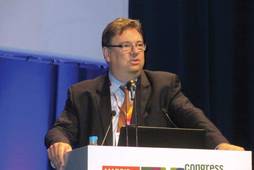
|
Dr. Antonio Llombart-Cussac |
In some countries, such as in the United States and Germany, dose-dense regimens are already standard, but not in other European countries including Spain, Italy, and France. One reason is that the dose-dense method costs more, as patients more often need support by treatment with granulocyte colony stimulating factor, an agent that can increase treatment costs three-fold. Some clinicians have also had lingering concern about the potential of the dose-dense method to boost episodes of secondary leukemia, So far, follow-up has shown no indication of increased hematologic malignancies in the German or Italian patients, but follow-up in these three trials has been brief, relative to the 10-20 years it could take for this adverse effect to appear. However, the immediate efficacy benefit from dose-dense treatment is important enough to justify using this approach even if we eventually see a small increased rate of late leukemias.
Dr. Antonio Llombart-Cussac is head of medical oncology at Arnau de Vilanova Hospital in Valencia, Spain. He has received honoraria as a speaker for or adviser to Celgene, GlaxoSmithKline, Roche, AstraZeneca, Novartis, and Lilly. He made these comments as a designated discussant for the reports and in an interview.
The results from these two German trials confirm that dose-dense chemotherapy regimens are extremely effective for adjuvant treatment of women with high-risk, node-positive early breast cancer of either the triple-negative type or with the luminal B phenotype.
U.S. researchers first reported similar findings in results published more than 10 years ago (J. Clin. Onc. 2003;21:1431-9), although concerns existed about the relevance of the treatment received by control patients in that study. Last year, Dr. Cognetti and other Italian researchers reported a significant benefit from a dose-dense regimen in a controlled study, but those results remain unpublished as of now. Further confirmation by these two German studies now clearly establishes dose-dense regimens as the standard of care for adjuvant treatment of these types of breast cancer patients. The intensified, dose-dense method is the preferred way to administer anthracyclines and taxanes for adjuvant treatment in these high-risk patients.

|
Dr. Antonio Llombart-Cussac |
In some countries, such as in the United States and Germany, dose-dense regimens are already standard, but not in other European countries including Spain, Italy, and France. One reason is that the dose-dense method costs more, as patients more often need support by treatment with granulocyte colony stimulating factor, an agent that can increase treatment costs three-fold. Some clinicians have also had lingering concern about the potential of the dose-dense method to boost episodes of secondary leukemia, So far, follow-up has shown no indication of increased hematologic malignancies in the German or Italian patients, but follow-up in these three trials has been brief, relative to the 10-20 years it could take for this adverse effect to appear. However, the immediate efficacy benefit from dose-dense treatment is important enough to justify using this approach even if we eventually see a small increased rate of late leukemias.
Dr. Antonio Llombart-Cussac is head of medical oncology at Arnau de Vilanova Hospital in Valencia, Spain. He has received honoraria as a speaker for or adviser to Celgene, GlaxoSmithKline, Roche, AstraZeneca, Novartis, and Lilly. He made these comments as a designated discussant for the reports and in an interview.
The results from these two German trials confirm that dose-dense chemotherapy regimens are extremely effective for adjuvant treatment of women with high-risk, node-positive early breast cancer of either the triple-negative type or with the luminal B phenotype.
U.S. researchers first reported similar findings in results published more than 10 years ago (J. Clin. Onc. 2003;21:1431-9), although concerns existed about the relevance of the treatment received by control patients in that study. Last year, Dr. Cognetti and other Italian researchers reported a significant benefit from a dose-dense regimen in a controlled study, but those results remain unpublished as of now. Further confirmation by these two German studies now clearly establishes dose-dense regimens as the standard of care for adjuvant treatment of these types of breast cancer patients. The intensified, dose-dense method is the preferred way to administer anthracyclines and taxanes for adjuvant treatment in these high-risk patients.

|
Dr. Antonio Llombart-Cussac |
In some countries, such as in the United States and Germany, dose-dense regimens are already standard, but not in other European countries including Spain, Italy, and France. One reason is that the dose-dense method costs more, as patients more often need support by treatment with granulocyte colony stimulating factor, an agent that can increase treatment costs three-fold. Some clinicians have also had lingering concern about the potential of the dose-dense method to boost episodes of secondary leukemia, So far, follow-up has shown no indication of increased hematologic malignancies in the German or Italian patients, but follow-up in these three trials has been brief, relative to the 10-20 years it could take for this adverse effect to appear. However, the immediate efficacy benefit from dose-dense treatment is important enough to justify using this approach even if we eventually see a small increased rate of late leukemias.
Dr. Antonio Llombart-Cussac is head of medical oncology at Arnau de Vilanova Hospital in Valencia, Spain. He has received honoraria as a speaker for or adviser to Celgene, GlaxoSmithKline, Roche, AstraZeneca, Novartis, and Lilly. He made these comments as a designated discussant for the reports and in an interview.
MADRID – A dose-dense, third-generation chemotherapy regimen surpassed a more standard regimen for adjuvant therapy of high-risk breast cancer patients with positive nodes and either triple-negative tumors or aggressive, luminal B phenotypes in an analysis of about 1,600 patients treated in two German phase III trials.
Adding these results to those from two prior phase III studies with similar findings firmly establishes the intensified, dose-dense approach as the preferred way to deliver third-generation chemotherapy to patients with these breast-cancer presentations, Dr. Christoph Thomssen reported at the annual congress of the European Society for Medical Oncology.
“We suggest adding iddETC [intense dose-dense epirubicin, paclitaxel, cyclophosphamide] to the group of preferred regimens in current guidelines,” said Dr. Thomssen, professor and director of gynecology at the University Clinic in Halle, Germany. Dr. Thomssen noted that some existing guidelines for breast cancer chemotherapy, such as from the National Comprehensive Cancer Network, already recommend dose-dense adjuvant therapy for breast cancer patients with positive lymph nodes and either triple-negative disease or the luminal B phenotype,
But in other countries, such as in Spain, France, and Italy, adoption of a dose-dense approach has not caught on, said Dr. Antonio Llombart-Cussac, head of medical oncology at Arnau de Vilanova Hospital in Valencia, Spain. For example, fewer than 5% of women with breast cancer who fit one of these high-risk profiles and receive treatment at a Spanish hospital currently get a dose-dense regimen, he said in an interview. The new evidence reported by Dr. Thomssen as well as results from an Italian study reported last year should together help change the practice of physicians who have not yet adopted the dose-dense approach, Dr. Llombart said.
The first German study, known as AGO ETC compared a standard schedule for administering epirubicin, cyclophosphamide, and paclitaxel sequentially at 3-week intervals with an accelerated schedule in which patients received dosages every 2 weeks: three sequential doses of 150 mg epirubicin/m2 every 2 weeks, followed by three sequential doses of 225 mg/m2 paclitaxel every 2 weeks, and finally three sequential dosages of 2.5 g/m2 cyclophosphamide every 2 weeks. The study randomized 1,284 patients with at least four positive lymph nodes during 1998-2003. During an average 5-year follow-up, the rate of event-free survival was 70% among patients on the dose-dense regimen and 62% among those on the standard regimen (P less than .001), a 0.72 hazard ratio (95% confidence interval 0.59-0.87), Dr. Thomssen reported.
The second trial he presented, known as GAIN (German Adjuvant Intergroup Node-Positive study), randomized 3,023 patients to either the same dose-dense regimen tested in the first study (but with 2.0 g/m2 cyclophosphamide), or to a second, different dose-dense regimen that also included capecitabine. Five-year results in this second trial showed a virtually identical, 80% event-free survival rate in each of the two treatment arms.
Dr. Thomssen highlighted the similarity of this 80% rate seen in 1,498 patients who received a dose-dense regimen that was very similar to the one used in the first study with the 70% event-free survival rate seen in the dose-dense arm of the first study. He concluded that these results from the GAIN trial validated the results from the first trial. Among patients in GAIN with at least four positive lymph nodes, who most closely matched the patients enrolled in the first trial, the 5-year event-free survival rate was 75%.
Additional subgroup analyses of results from the first trial showed that the added benefit from the dose-dense regimen occurred consistently across all patient subgroups. The dose-dense regimen was also well tolerated, producing about a 7% rate of febrile neutropenia, and a cardiac failure rate of less than 1%. The most common adverse event was peripheral neuropathy, which occurred in 25%-55% of treated patients.
On Twitter @mitchelzoler
MADRID – A dose-dense, third-generation chemotherapy regimen surpassed a more standard regimen for adjuvant therapy of high-risk breast cancer patients with positive nodes and either triple-negative tumors or aggressive, luminal B phenotypes in an analysis of about 1,600 patients treated in two German phase III trials.
Adding these results to those from two prior phase III studies with similar findings firmly establishes the intensified, dose-dense approach as the preferred way to deliver third-generation chemotherapy to patients with these breast-cancer presentations, Dr. Christoph Thomssen reported at the annual congress of the European Society for Medical Oncology.
“We suggest adding iddETC [intense dose-dense epirubicin, paclitaxel, cyclophosphamide] to the group of preferred regimens in current guidelines,” said Dr. Thomssen, professor and director of gynecology at the University Clinic in Halle, Germany. Dr. Thomssen noted that some existing guidelines for breast cancer chemotherapy, such as from the National Comprehensive Cancer Network, already recommend dose-dense adjuvant therapy for breast cancer patients with positive lymph nodes and either triple-negative disease or the luminal B phenotype,
But in other countries, such as in Spain, France, and Italy, adoption of a dose-dense approach has not caught on, said Dr. Antonio Llombart-Cussac, head of medical oncology at Arnau de Vilanova Hospital in Valencia, Spain. For example, fewer than 5% of women with breast cancer who fit one of these high-risk profiles and receive treatment at a Spanish hospital currently get a dose-dense regimen, he said in an interview. The new evidence reported by Dr. Thomssen as well as results from an Italian study reported last year should together help change the practice of physicians who have not yet adopted the dose-dense approach, Dr. Llombart said.
The first German study, known as AGO ETC compared a standard schedule for administering epirubicin, cyclophosphamide, and paclitaxel sequentially at 3-week intervals with an accelerated schedule in which patients received dosages every 2 weeks: three sequential doses of 150 mg epirubicin/m2 every 2 weeks, followed by three sequential doses of 225 mg/m2 paclitaxel every 2 weeks, and finally three sequential dosages of 2.5 g/m2 cyclophosphamide every 2 weeks. The study randomized 1,284 patients with at least four positive lymph nodes during 1998-2003. During an average 5-year follow-up, the rate of event-free survival was 70% among patients on the dose-dense regimen and 62% among those on the standard regimen (P less than .001), a 0.72 hazard ratio (95% confidence interval 0.59-0.87), Dr. Thomssen reported.
The second trial he presented, known as GAIN (German Adjuvant Intergroup Node-Positive study), randomized 3,023 patients to either the same dose-dense regimen tested in the first study (but with 2.0 g/m2 cyclophosphamide), or to a second, different dose-dense regimen that also included capecitabine. Five-year results in this second trial showed a virtually identical, 80% event-free survival rate in each of the two treatment arms.
Dr. Thomssen highlighted the similarity of this 80% rate seen in 1,498 patients who received a dose-dense regimen that was very similar to the one used in the first study with the 70% event-free survival rate seen in the dose-dense arm of the first study. He concluded that these results from the GAIN trial validated the results from the first trial. Among patients in GAIN with at least four positive lymph nodes, who most closely matched the patients enrolled in the first trial, the 5-year event-free survival rate was 75%.
Additional subgroup analyses of results from the first trial showed that the added benefit from the dose-dense regimen occurred consistently across all patient subgroups. The dose-dense regimen was also well tolerated, producing about a 7% rate of febrile neutropenia, and a cardiac failure rate of less than 1%. The most common adverse event was peripheral neuropathy, which occurred in 25%-55% of treated patients.
On Twitter @mitchelzoler
AT ESMO 2014
Key clinical point: A dose-dense chemotherapy regimen surpassed conventional dosing in high-risk breast-cancer patients.
Major finding: A dose-dense regimen produced 70% 5-year event-free survival, compared with a 62% rate with standard treatment.
Data source: AGO ETC and GAIN, two multicenter, controlled phase III German trials with a total of 2,141 patients receiving the dose-dense regimen.
Disclosures: The two investigator-initiated trials received grant support from Amgen, Bristol-Myers Squibb, Janssen-Cilag, and Roche. Dr. Thomssen has received honoraria as a speaker for Amgen, Celgene, Pfizer, Roche, Sanofi-Aventis, and TEVA.

